
2


2
In the second half of the 19th century, the banks of the Maribyrnong River became the central powerhouse of Melbourne’s industrial wealth.
Fast forward to today, and those industrial areas along the River are becoming sought-after residential areas, with occupants enjoying the waterside location and city views.
Just as our municipality continues to reinvent and transform itself, those who live here have also changed. With its close proximity to the Melbourne CBD and our reputation as a multicultural hub, it continues to welcome an influx of young people and families from diverse cultures and backgrounds, who wish to call the heart of the inner-west home.
One thing that hasn’t changed is the welcoming nature of Maribyrnong, which continues to attract migrants from the world over to settle here. Through food and celebration, this diverse community has left its mark on the cultural tapestry of our City.
To commemorate this history and uncover further gems, Council, in partnership with Footscray Community Arts, is delivering this art exhibition
– HIDDEN Footscray – showcasing works by six local artists: David Hourigan, Deb Bain-King, Jody Haines, Kerrie Poliness, Jason Waterhouse, and Felicity Watson, with an essay by local author and academic Dr John Weldon.
The exhibition aims to highlight diverse aspects of overlooked culture, heritage and geography within Footscray specifically, and deliver an engaging audience program to support viewers as they discover Footscray through art.
Come uncover and celebrate the forgotten stories, and join us as we shine a light on the past to highlight the vibrant and rich cultural history of Footscray, and its hidden gems.
Councillor Sarah Carter Mayor, Maribyrnong City Council
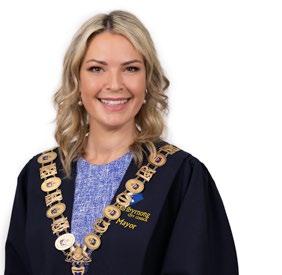 Front cover image: David Hourigan Footscray TV and HiFi Repair Store 2021 sculpture foam, plastic card, plaster, wire, paper, metal foil, 34cm x 43cm x 26cm
Front cover image: David Hourigan Footscray TV and HiFi Repair Store 2021 sculpture foam, plastic card, plaster, wire, paper, metal foil, 34cm x 43cm x 26cm
HIDDEN Footscray is part of the wide range of services, programs and advocacy delivered by the Arts and Culture Unit of Maribyrnong City Council.

“The arts are a source of delight, invention and provocation. They help define us as human beings and shape our view of the world. At Maribyrnong City Council, we also strive to ensure art is a mechanism for place making, building social cohesion and a vehicle for social justice. Participation in the arts is a source of community wellbeing and a driver of economic vitality. Put simply, our investment in the arts is a catalyst for a better community.”
(Arts and Culture Strategy 2018-2023)
• Deliver the Arts and Culture Strategy 2018-2023 and Public Art Strategy 2019-2029
• Provide funding, low-cost leases and asset management of Council facilities for local arts and heritage organisations
• Provide affordable creative spaces and artist-in-residence programs for independent artists
• Encourage sector development through capacity building workshops, partnerships and mentorships
• Produce arts programs for the community
• Commission and maintain public, street art and visual arts projects
• Provide custodianship and management of Council’s Art and Heritage Collection
• Provide advocacy, promotion and support for the arts, creative and heritage sectors of Western Melbourne
To find out more, go to: www.maribyrnong.vic.gov.au/arts-and-culture

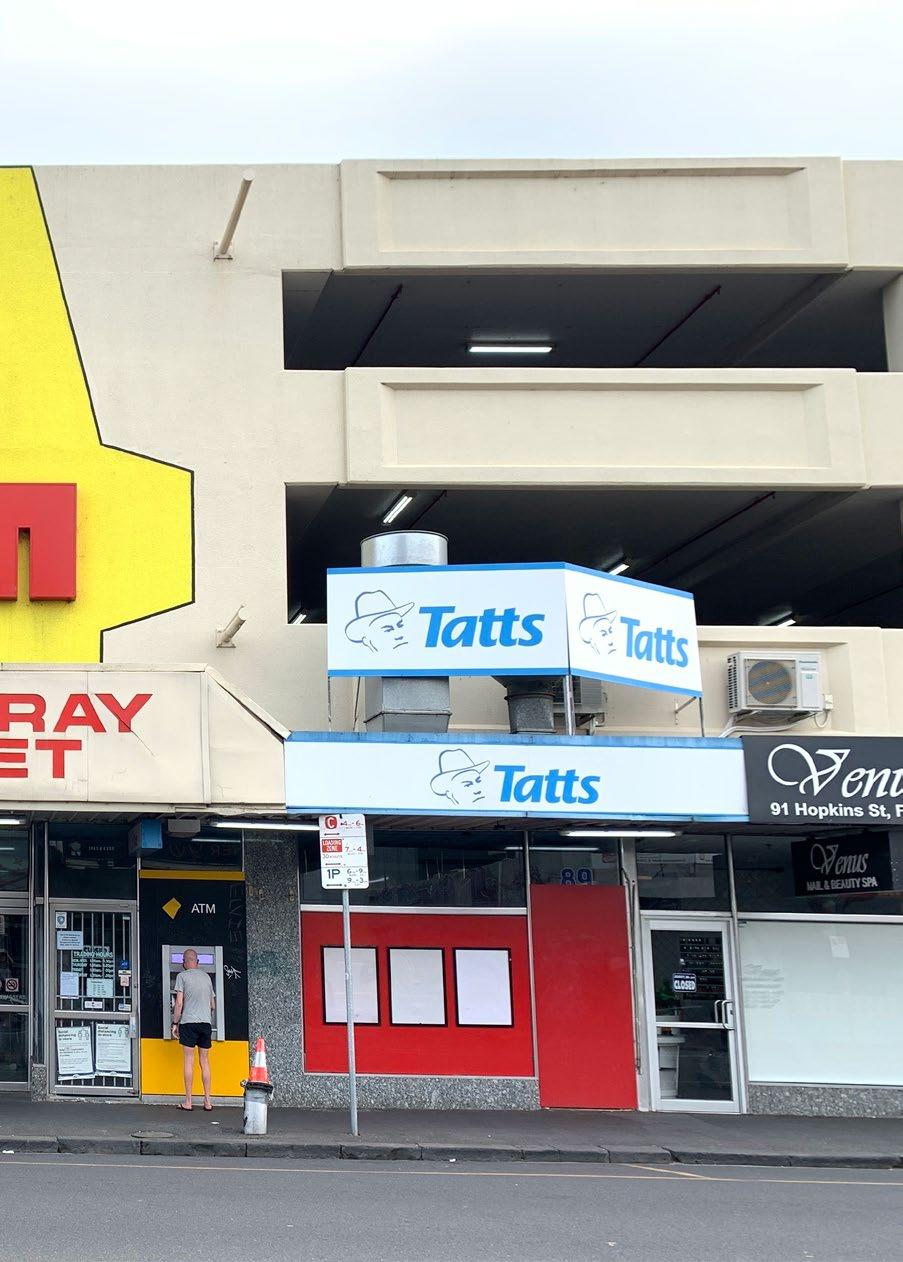
Not everything that is hidden is deliberately concealed. An action, idea, person or place can manifest in plain sight and still evade discovery. Perhaps we’re not present enough, perhaps we blinked when we should have looked, or maybe we lack the wherewithal to recognise what it is we see, are living amongst, on top of and within. Perhaps our grandparents forgot to tell us what we needed to hear and so ways of knowing become lost as time slips between us and understanding. Sometimes circumstance and expediency force us to hide things. Sometimes, someone just puts up a fence.
Felicity Watson’s work, Footscray Fresh scouts the chinks in those fences, affording glimpses into backyards verdant with produce that made the hard migrant journey along with those who grow it still. She unearths this idea of an edible Footscray, peeling back the layers of industry and colonisation. Looking for traces of the Kulin and how and what they grew in this land.
Deb Bain-King digs right into those layers, through concrete, bluestone and tar to discover, remember and pay respect to Billy Button Creek, for thousands of years the only source of fresh water in Footscray. Now forgotten, what’s left of this stream emerges from underground running as a gutter down Lyons Street into the Saltwater River. What stories lie hidden in its straitened course?
Jason Waterhouse’s work Automotive Geologies speaks of the steel that is drawn from the ferrous basalt reef that underpins the entirety of Footscray; how we strive to free this metal from its rocky bones and how nature relentlessly works to thwart us, drawing the iron back underground rusty drip by rusty drip.
Kerrie Poliness explores the very edge of this basalt reef, the last remaining untouched part of the pre-invasion landscape left in Footscray. Jutting out above the river, silent, vast, available, yet unnoticed. Invisible in its immutable permanence, background and witness to all who have walked this valley. Her work asks us to see what has always been there.
From that escarpment we might once have glimpsed the blue lake, the western swamp, a wetland drained by early settlers, reimagined now by Jody Haines who asks, ‘What isn’t there?’ What is hidden from us by the decisions our ancestors made? What might have been had the layers not been laid?
David Hourigan’s work returns us to a yesternow, asking us to look closely at what we are in the process of losing, what gems are we crushing beneath the massy wheels of change? By making small the everyday, he forces us to look in detail at that which is too much a part of us to be seen with the naked eye.
These works encourage us to notice, to fossick, to ask questions and to be curious, to look underneath and through gaps in fences and histories. They challenge us to find out and yet they also bid us pause, to deliberately place ourselves in a landscape and let the hidden discover us.
Associate Professor Dr John Weldon Victoria UniversityJohn Weldon in front of Dogs of the West mural (detail) 2019 Justine McAllister, Irving Street, Footscray
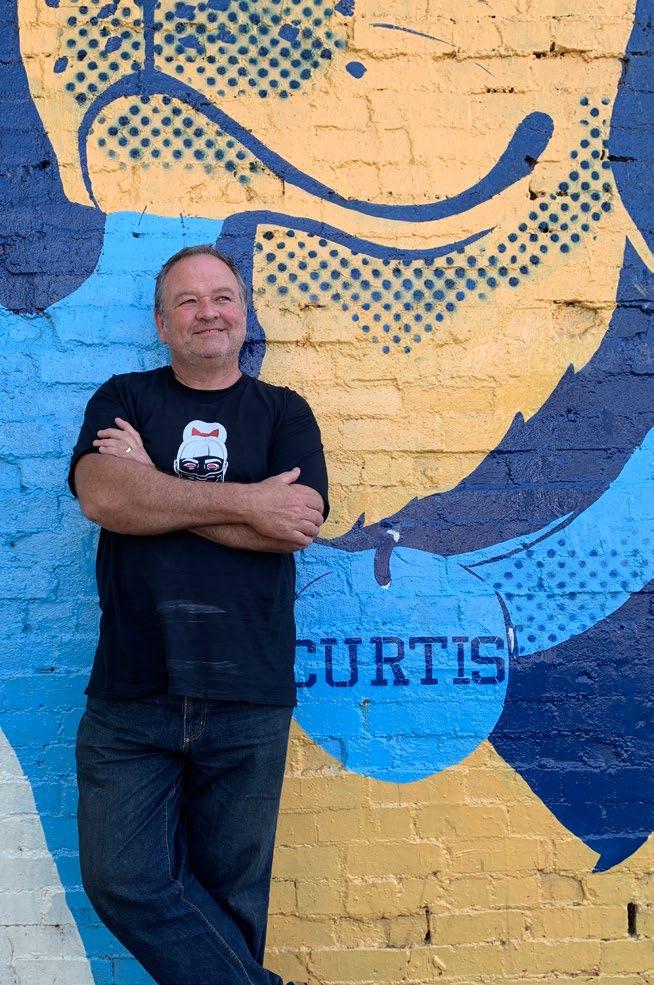

Top: David Hourigan, Franco Cozzo’s original Footscray warehouse 2021 plastic card, wood, foam, wire, metal foil, plaster, 21 x 67 x 19cm

Bottom: Archival photograph Franco Cozzo warehouse c. 1965. www.francocozzo.com.au

David Hourigan produces miniature art inspired by the suburbs of Melbourne, and in particular the inner west where he lives. He aims to capture the overlooked, the inconsequential, the quirky and the derelict urban scenes of Melbourne and surrounds.
Hourigan spent twenty years as a graphic designer and art director, before walking away from the corporate world to work as an artist full time in late 2018. His love of typography and advertising influences his choice of subject matter, with many of his miniatures featuring abandoned shop fronts and decades old signs.
“I want to record those unloved buildings most at risk of demolition, and show my audience the beauty that can be found in the unimposing.”
His work was shortlisted in the 2019 Footscray Art Prize, and has been featured in several solo and group exhibitions. His miniatures are held in private and institutional collections including the iconic Footscray Doughnut Van, which was recently acquired by the State Library of Victoria for its permanent Collection.
To me, the theme of HIDDEN Footscray is about shining a light on our lost streetscapes. I wanted to recreate in miniature form some of the hidden and forgotten urban scenes of Footscray.
Two of my artworks represent buildings which are long gone, demolished in the 1970s. One is Franco Cozzo’s original warehouse, an old door factory in Footscray, which was the surprisingly humble start to his furniture fame. The second is a typical corner store, which stood near the corner of Barkly Street and Summerhill Road. These sort of small corner stores were once ubiquitous, in every neighbourhood, but most are now gone. Both of these pieces were recreated from original black and white photos, the only evidence that they ever existed. Finding and researching these, bringing them back from being forgotten, was my small way of saving them from being hidden.
My third artwork, the Footscray TV and HiFi Repair Store, represents a building that still stands. It is inconsequential, easily missed, and yet it is a hidden gem, a rare and tiny piece of the past that hasn’t been paved over or redeveloped – but for how long?
There is unlikely beauty hidden in the everyday streets around us, just waiting to be discovered.
Top: David Hourigan, Footscray TV and HiFi Repair Store 2021, sculpture foam, plastic card, plaster, wire, paper, metal foil, 34cm x 43cm x 26cm
Bottom: Photograph Footscray TV and HiFi Repair Store 2021, Buckley Street. Image: David Hourigan



Circling the Water 2020, air-dropped walking map
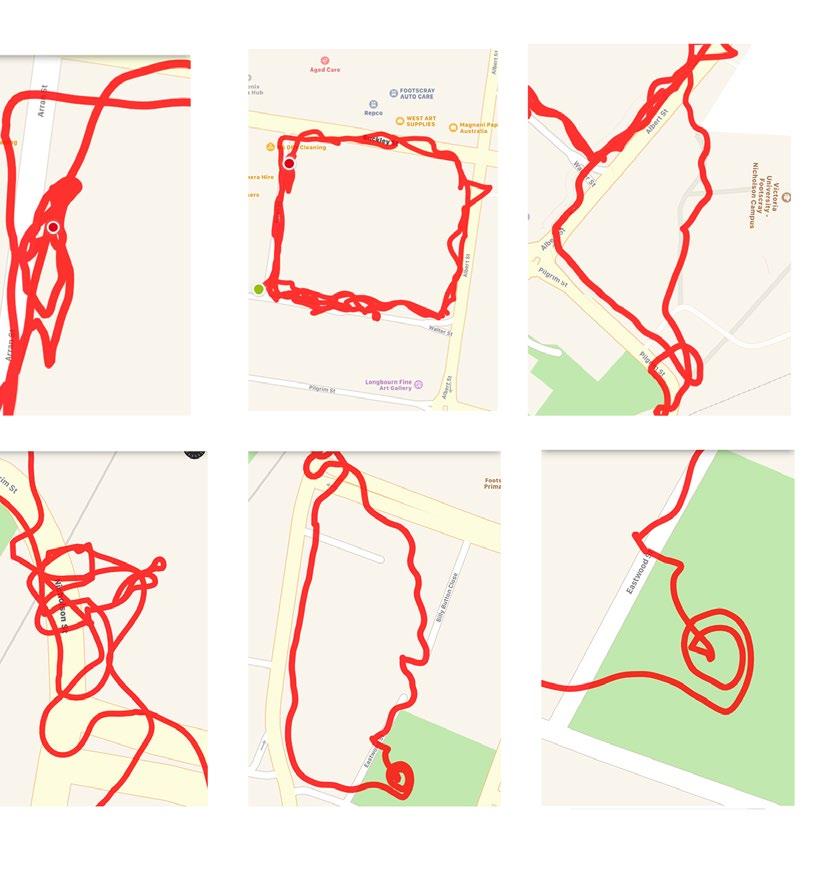 Deb Bain-King
Deb Bain-King
Deb has worked as a collaborative and solo artist for the last 13 years exhibiting with galleries at Monash, RMIT, ACCA and a range of private and artist run spaces in Melbourne.
Deb has wide experience with projects in public space. Her practice as an artist engaged with social issues has led to time in Israel, the US, the UK, Vietnam, Scotland, India, and China. She has worked with projection and street based performance, often in combination. The use of performance has led onto an interest in public ceremony, ritual, women’s psychological space, and their displacement and connection to place.
Deb was on the committee of Trocadero Art Space in Footscray for a number of years and ran The Front Art Space, part of a Renew Australia project in the Docklands precinct for two years. She is now Public Liaison Officer for Little.No BIG gallery in Footscray. Deb has a Masters in Fine Art from Monash University and a Graduate Diploma in Art in Public Space from RMIT.
Finding connection to place and community through walking allows a place to tell me lost things. I’ll sit and draw with my eyes closed and I hear what the place wants to tell me. Then I ask questions and people tell me stories.
In this way I met Pam Mulready, the late Peter Haffenden and Tony Kelleher, story tellers/ historians working to restore an expanded history to the public domain. Billy Button Creek ran through Hobbs Well Reserve at 43-57 Buckley Street, Footscray. The creek was the only source of freshwater in the area pre- and post-invasion. There were two wells on the site, too. It was a loved meeting place for the women and children. The reserve was sold by the town clerk without the community knowing in 1919.
Where the Water Gathers is a series of actions taken to enable me, as a descendant of invaders, to honour the creek. I walked along the Billy Button Creek line, circling each low-lying place, thanking the creek for the gift of water. I enacted shipwrecked women clasping lace curtains, colonial women using the creek to wash clothes, and, in recognition that their aspiration displaced the original owners, I returned rainwater to the lost creek to acknowledge the destruction. Measuring events took place with the dimensions of the reserve marked on the pavement. And I stencilled Billy Button flowers along the boundary, to slowly disappear, like the creek.
The story spread. There is a Public Pedagogies Institute podcast. Musician Jennifer McSweeney wrote a song for the creek and the Wefo Singers sang it as part of my ArtsBox residency at the Footscray Library. A book is being made. A walking map to follow my walk is available. See what you can find. For that’s how we come to be part of where we live and learn to care for the land that we live on.
Deb Bain-King (performance)
Where the Water Gathers, Manallack Reserve 2020-2021, image credit, Emma Byrnes

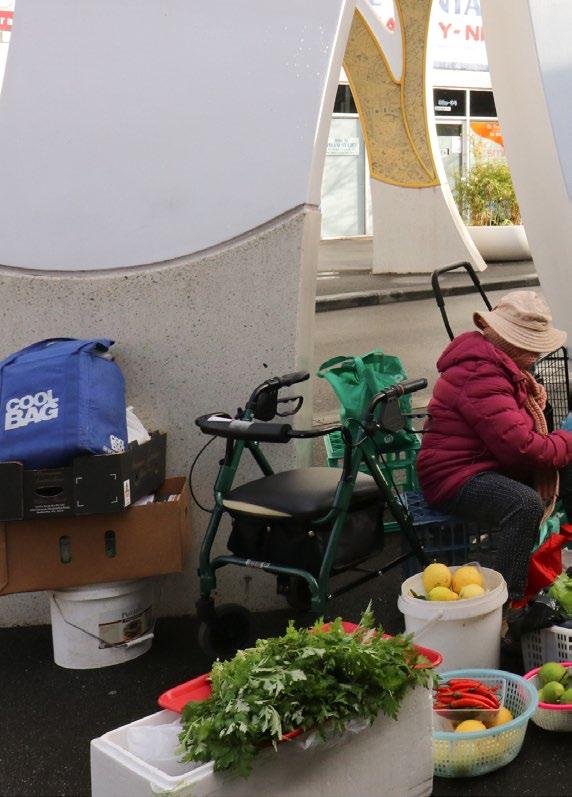
Footscray Fresh series Saigon Welcome Arch 2021 photographic print 20 x 30cm
 Felicity Watson
Felicity Watson
Felicity Watson is a Footscray resident, heritage expert, writer, and keen photographer. Her work encompasses the observation, documentation, and interpretation of the histories and cultural values that are embedded in the places that we navigate in our day to day lives.
As a keen home cook, who is privileged to live in the culturally and gastronomically diverse suburb of Footscray, Felicity is also interested in thinking about the provenance of the things we eat, and the cultural forces that shape our consumption.
In Footscray Fresh, Felicity looks through the lens of her COVID-19 5km lockdown bubble to examine histories of food production in Footscray, the traces of these histories that remain in the landscape, and how the currents of colonisation and dispossession, capitalism, migration, and environmental degradation and renewal have shaped the way we eat.
In the early days of the COVID-19 pandemic, Victorians were confronted with the unusual sight of bare supermarket shelves, stripped of staples like flour, pasta, and tinned tomatoes. As container ships were stalled, and local meat processing plants were thrown into lockdown, our supply chains, usually hidden from sight, suddenly became more visible.
For me, the sudden absence of the products we take for granted sparked curiosity. Confined for more than 100 days within a 5km radius of my home, I began to wonder—where does the food that sustains our community come from? And how has this landscape sustained communities for tens of thousands of years?
Top right: David’s edible garden, 2021. In the backyard of his Footscray home, David Elliot has created a sub-tropical paradise, bringing the world to his table with more than 50 varieties of fruiting trees, shrubs and vines.
Bottom right: Rudimentary, 2021. On the site of a former carpark, cafe owner Des Huynh has created a thriving kitchen garden that connects customers to the source of their food. It is also shared by local community members and a happy hive of bees.
Home to untold generations of the Marin Balluk and Yallukit Willam peoples, the place we now know as Footscray was once a landscape of plenty—the Maribyrnong River and the grasslands of the volcanic plains sustaining an abundance of plant and animal life. With invasion, and the introduction of livestock, Footscray transformed into an industrial food processing powerhouse, which not only fed Melbourne, but the world. Today, paddocks are being transformed back in to wetlands, while keen home gardeners feed their communities, and sell their produce at the unofficial street market under the Saigon Welcome Arch.
Footscray Fresh is a series of contemporary photographs, accompanied by illustrated online texts which document Footscray’s productive landscape and peel back the hidden layers of our historic environment.
https://footscrayfresh.com
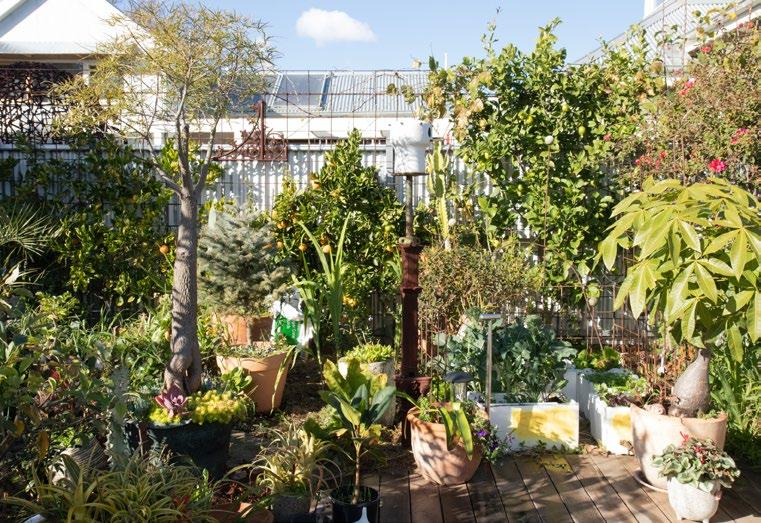
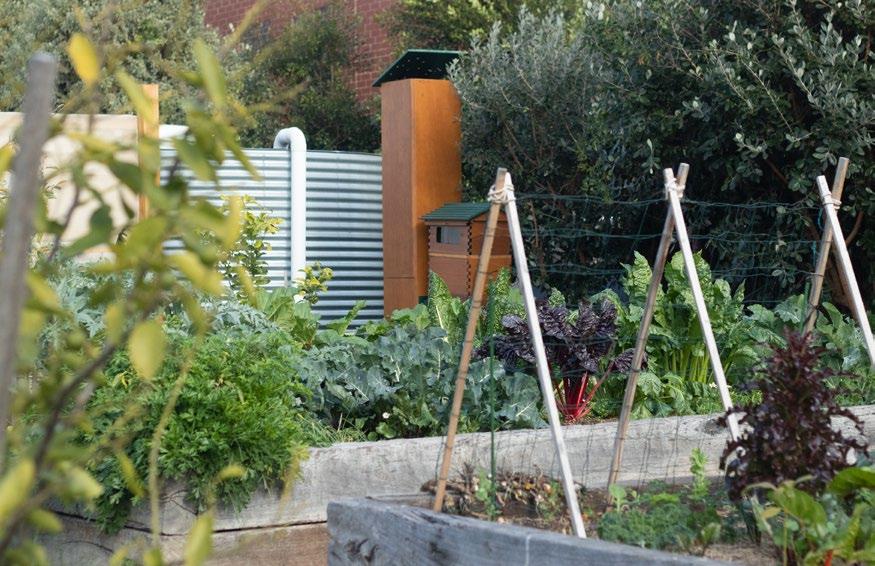
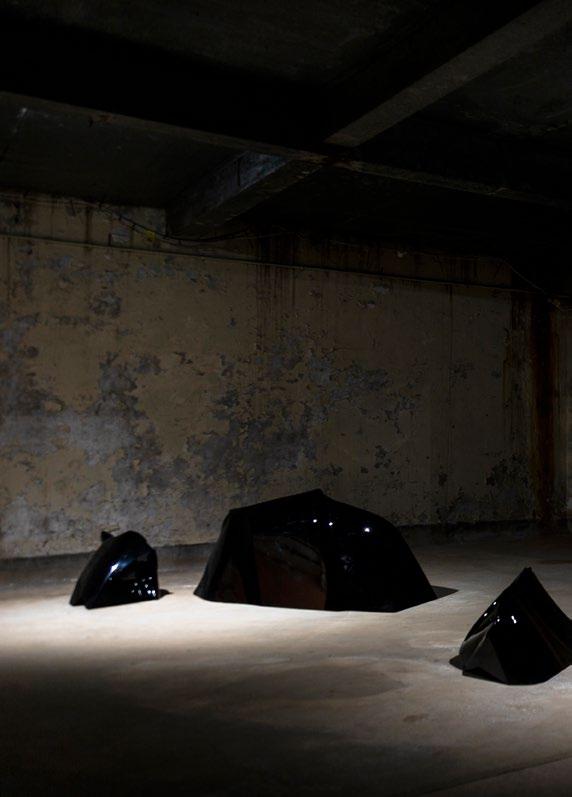
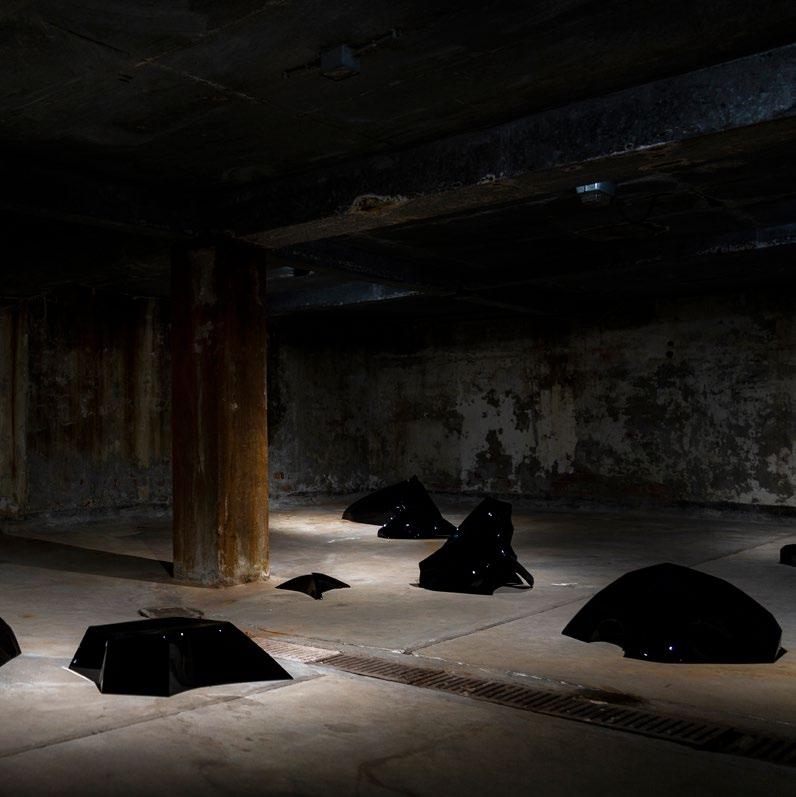
Steel, polyester filler, automotive paint, car panels (bonnets, fenders, doors, boot lids) from: Toyota, Hyundai, Mazda, Holden, Humber, Mitsubishi
Over the last twenty years, Jason Waterhouse has been applying his malleable skills to public commissions, installation and drawing, articulating his poetic relationship to the world by warping and manipulating utilitarian objects. Advocating a non-elitist form of art making, Waterhouse thrives on altering spaces and objects through a strong craft sensibility combined with the Western idea of the ready-made.
Jason Waterhouse’s practice plays with autobiographic notions of contemporary Australian identity and he is widely known for playfully manipulating tools, cars, sheds and other cultural signifiers. Previous works have involved a series of interventions resulting in a hybridised object that occupies a space between the natural and the manufactured. Jason Waterhouse completed a BFA in sculpture at Monash University and Post-Grad at the Victorian College of the Arts. Over the last twenty years, Waterhouse has exhibited his work extensively in Australia, including at the Biennale of Australian Art, Ballarat (2018) and Scienceworks Museum, Melbourne (2016). His recent public art commissions include Levelled Crossing, Melton Highway, Brimbank Council and Cottage, Daylesford Lake, Hepburn Shire.
For HIDDEN Footscray, Jason Waterhouse presents Automotive Geologies, a series of sculptures created from the panels of cars which present like hybridized geological car forms. The works explore ideas of material origins and industry. In the rapidly gentrified and postindustrial future of the inner west, Automotive Geologies occupy the space like hybrid ghosts of the areas industrial past, slipping and shifting back into the third largest Basalt plain in the world.
Automotive Geologies 2018 variable dimensions
Steel, polyester filler, automotive paint, car panels (bonnets, fenders, doors, boot lids) from: Toyota, Hyundai, Mazda, Holden, Humber, Mitsubishi
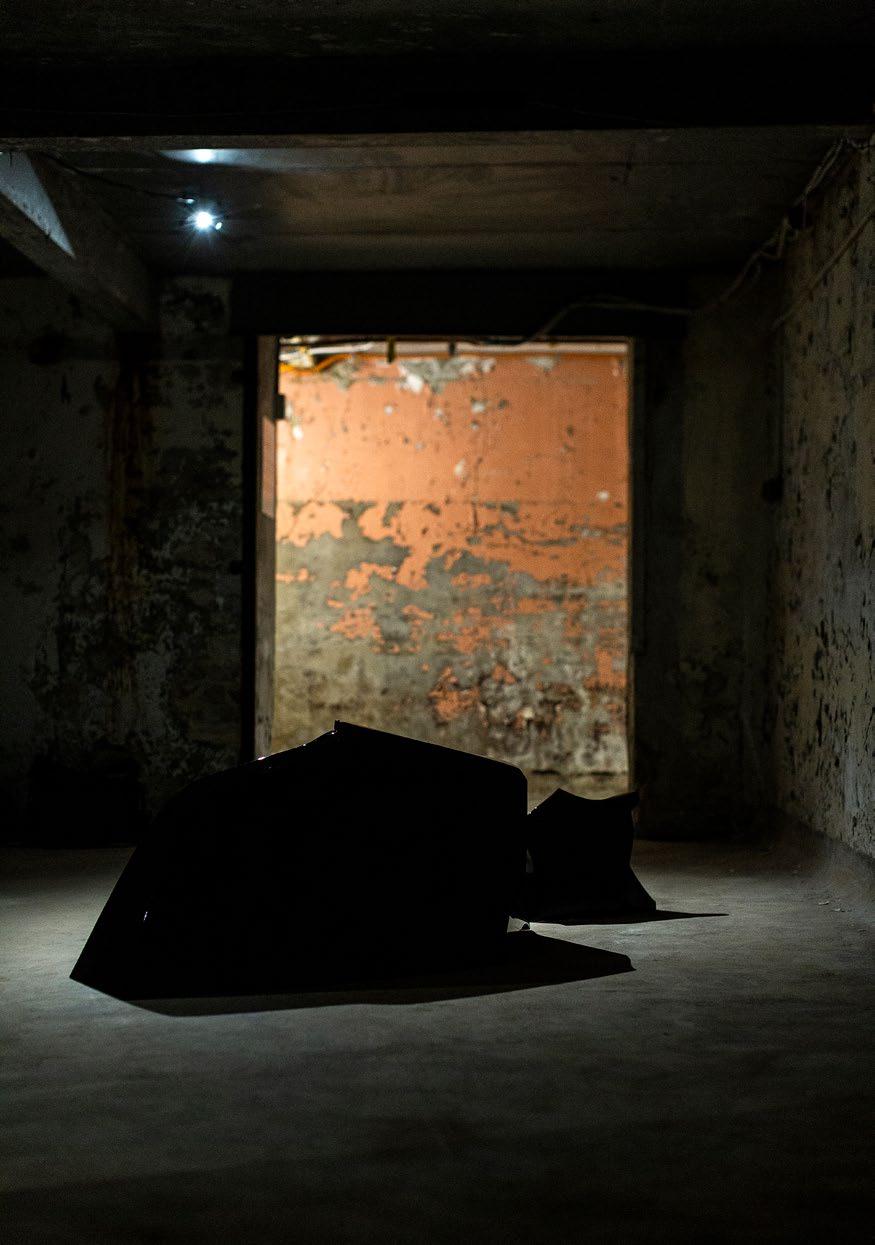
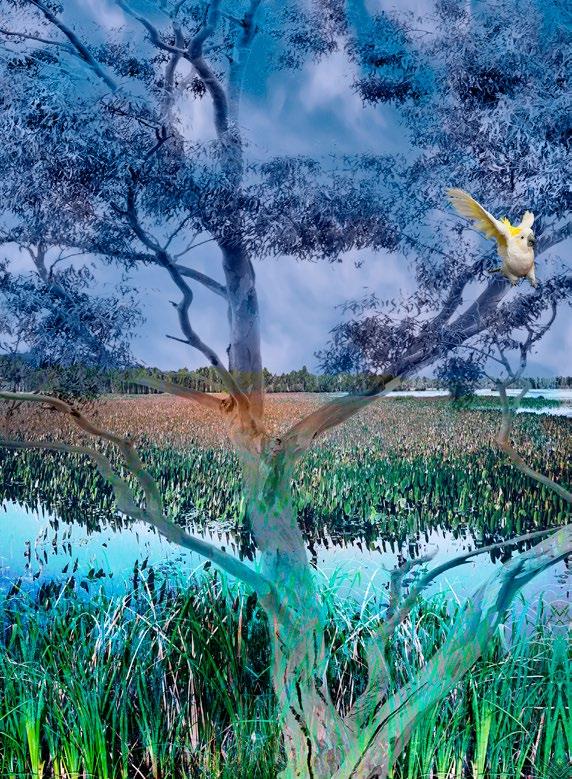
(detail) A dreamed wetlands composite image
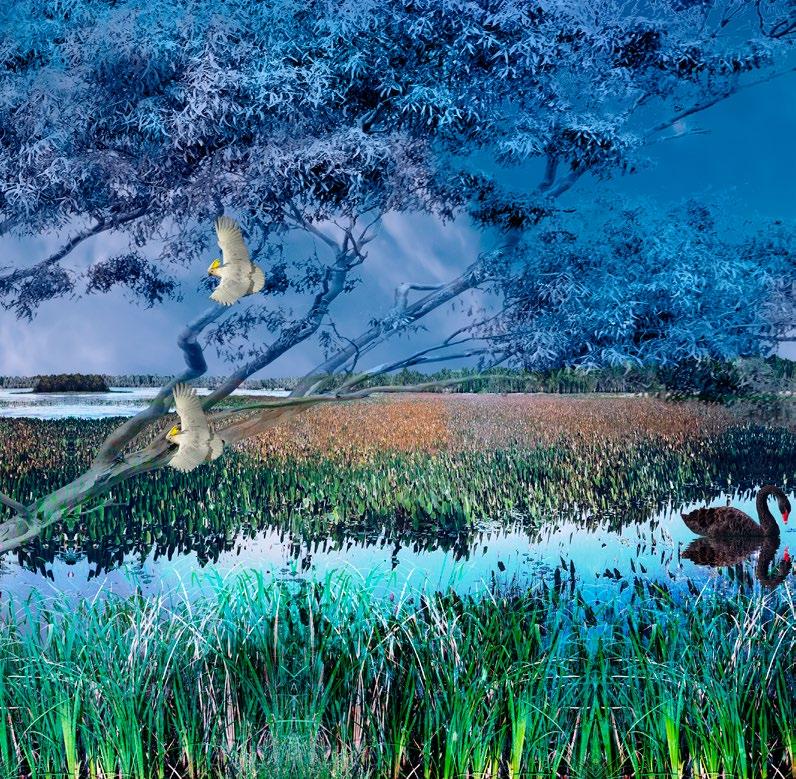
The Last Supper series 2021
Installation (7 digitally printed Perspex panels, table, sheoak needles) variable dimensions table 150cm diam. 40cm H
Maribyrnong City Council Art and Heritage Collection
Jody Haines is a photo-media artist based in Melbourne, Victoria. By approaching photography as a social practice, Jody collaboratively focuses on identity, representation, and the female gaze, from a decolonial feminist perspective.
Applying her social practice approach to photography, Jody has been commissioned to collaborate with local communities across Australia, producing work for festivals and programs, including Women Dreaming Project (Women of the World 2018, Gold Coast Commonwealth Games), Our people Our place (Horizons Festival 2019), and #IAMWOMAN an ongoing relational photographic series (including Arts House 2019, Immerse Public Art Festival 2018 and One Night in Footscray 2018).
Exhibitions include Photo 2021 International Festival of Photography, at Footscray Community Arts Centre, Tell: Contemporary Indigenous Photography Sydney Festival 2018 Ballarat International Foto Biennale 2017, Gertrude Street Projection Festival 2017 (Atherton Towers), Dance Massive 2019, Channels Festival 2019 and West Projections 2020. Most recently showing in the group show Here I Am: Art by Great Women in conjunction with Know My Name (National Gallery of Australia).
Jody is a PhD candidate at RMIT School of Art and lives and works on the lands of the Wurundjeri and Boon Wurrung peoples. She is a descendant of the Tommeginner people (Northwest Tasmania).
In 2020, while researching the concept and design of a public artwork for a precinct in North Melbourne, I explored some of the histories of Melbourne’s many wetlands for inspiration.
Between the banks of the Birrarung, the Maribyrnong River and the hills of what became North Melbourne lived a vast wetland and, in her centre, lay a blue saltwater lake. A wetland that connected to the west and provided for the Kulin Nation peoples - food, building supplies and medicinal plants. A wetland abundant with life, purple haloed and aqua blue, the salt waters formed an aviary for swans, ducks and quail. Cockatoo and parrakeet. A fishing ground brimming with eels and trout. A gathering ground of manna, pig face, tea tree and she-oak . A wetland lost through destructive settler colonial intervention.
The Last Supper, 2021 builds on the research and is a decolonial intervention into the colonial structure, a site of ongoing resistance.
The installation consists of a Chandelier and table.
Jody Haines (detail) from Chandelier shape #2 The Last Supper series 2021


Untitled Landscape Painting Exhibition, Basalt Escarpment, Farnsworth Avenue, Footscray 2021

Images courtesy the artist and Anna Schwartz Gallery

Kerrie Poliness is a Melbourne-based artist living in Footscray since 1995. Since 1985 she has exhibited extensively in Australia and elsewhere. She co-founded Store 5 gallery (1989-91) and has carried out various architectural, cultural, heritage and environmental projects in collaboration with a wide range of groups and individuals, a number in association with Melbourne’s Living Museum of the West (1993 onwards) including: Still Here with Uncle Larry Walsh (1996); Pobblebonk (2005) and Volcano Dreaming (2011) with Peter Haffenden. Kerrie is on the Board of West Space (2014 -2022) and completed a PhD with the Centre for Ideas at the VCA, University of Melbourne (2019).
Recent exhibitions include: Walking Drawings, on Parliament House steps in Melbourne with ACCA and Uptown (2021); Library Drawing, National Library Canberra forecourt, with Contour 556 (2021); Never the Same River, Anna Schwartz Gallery, Melbourne (2019); Today, Tomorrow, Yesterday, Museum of Contemporary Art, Sydney (2017-19). Local integrated public artworks include the Pipestacks (1999) and the Pioneer Women’s Shelter (1997) in Pipemakers Park; and Wave Drawings (2013) at Highpoint Shopping Centre. Recently and more broadly, Stream, a permanent artwork integrated within the new Drying Green Park in Green Square for the City of Sydney opened in October 2022. Kerrie is represented by Anna Schwartz Gallery.
Revisiting the exhibition of a single red diamond painting held in 1999, the one day exhibition shown in the video was made in 2021 as part of an ongoing project with this particular place and our local Volcanic Plains.
The rock-face is possibly the only remnant basalt escarpment left in Footscray. Basalt (or bluestone) is solidified lava. Much of Melbourne is built of this material. To the west across Victoria, more than 400 volcanoes are known collectively as ‘the Victorian Volcanic Plains’. The intermittent flows of lava from two million years of volcanic eruptions formed this landscape. This escarpment indicates where the lava stopped, the edge of this slow lava wave. Water running down its steep slope formed the Maribyrnong River Valley and its wetlands.
The coloured objects are “non-objective landscape paintings”. The particular scale and proportion was first developed in 1999 to make exhibitions outdoors, to engage with environments through painting in a nonrepresentational and experimental way. The paintings are portable, not too big or small, and are made of robust, lightweight materials. Many exhibitions have been made and documented in various places. While the paintings don’t damage the environment they often become marked through this activity. The process of choosing locations and colours, and installing and recording these exhibitions is an ongoing activity which enables me to closely consider nature and places through making art.
Kerrie Poliness
Untitled Landscape Painting Exhibition, Basalt Escarpment, Farnsworth Avenue, Footscray 2021
Images courtesy the artist and Anna Schwartz Gallery
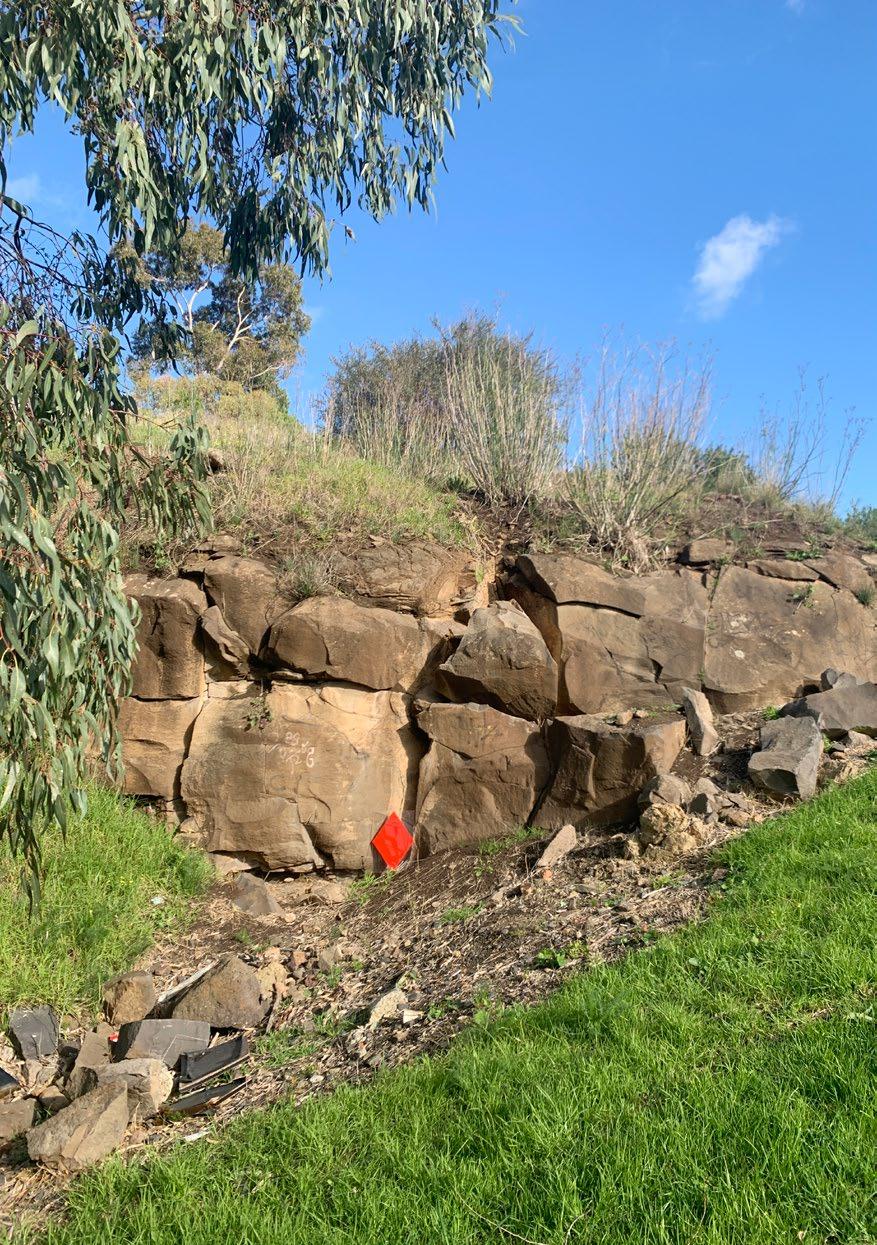
Maribyrnong City Council gratefully acknowledges the following for their generous contributions to, and support of this project:
Deb Bain-King, Jody Haines, David Hourigan, Kerrie Poliness, Jason Waterhouse, Felicity Watson.
Associate Professor Dr John Weldon.
Nicola Vance Bernadette Fitzgerald

Aboriginal History Archive, Victoria University Footscray Historical Society, Footscray Melbourne’s Living Museum of the West, Maribyrnong
© Artists, photographers, authors and Maribyrnong City Council, 2023. All rights reserved. No part of this publication may be reproduced or transmitted in any form or by any means, electronic or mechanical, including photography, recording or any other information storage or retrieval system without prior consent in writing from the publisher, the artists, the photographers and the authors. Images remain copyright of the artists, photographers and appropriate authorities. All opinions expressed in this publication are those of the authors and not necessarily those of the publisher.